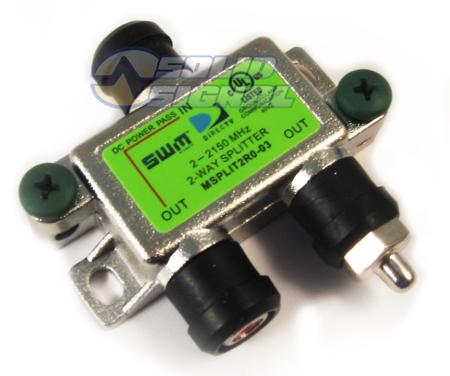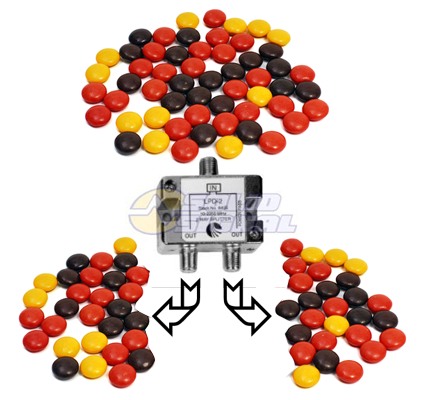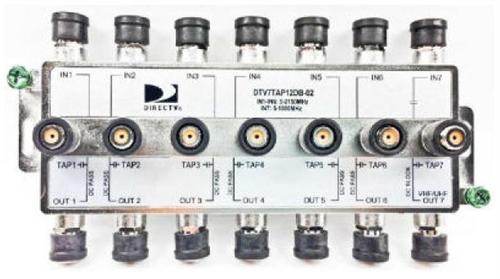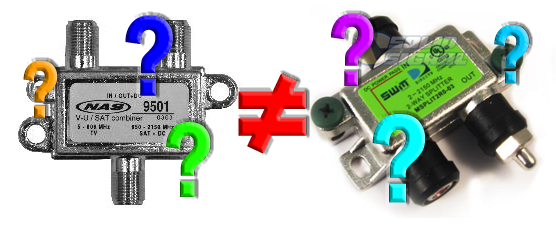If you’re not sure of the difference between a diplexer and a splitter, you’re not alone.It’s very confusing to know the difference between a splitter, a combiner, a tap, and a diplexer. To make matters worse, some splitters are also combiners, and some diplexers are also combiners. Parts can be active or passive, powered, or unpowered, and without a magnifying glass (or some really good eyesight) they can all look identical.
What is a splitter?

The most common use of a splitter is to add an additional television to an existing cable. If you have an antenna, you can use a splitter to make that antenna serve more than one television. If you have a cable or satellite system, you might be able to use a splitter to add TV to another room. Most modern systems are designed to use a splitter in this way, but older systems make you run a separate line to each TV from a central switch. Make sure you know if you have a “splittable” system.
Splitting seems like an easy way to add extra outlets, but remember that each time you split a signal you cut its strength in half. Look at this diagram:

This is what a splitter does. When you split out the signal you only send half as much through each line. It may seem like you have a great quality signal but split it too many times and it won’t get the job done.
What is a tap?
Think of a tap as a special-purpose splitter. In a normal splitter, all the splits are equal. If you have a 1-in, 2-out splitter (referred to as a 1×2) then half of the signal goes to each output port. In a tap, the signals are not equal… you could have a tap that sends out 9dB less signal on one port than the other. This is used to have a very strong signal that goes a long distance without damaging some of the closer pieces of equipment. A do-it-yourselfer would have almost no reason to use a tap. It could be used to steal cable TV from older systems, but modern systems have protections in place to stop this sort of theft.

Taps are used in commercial installations all the time. In a case like this, the purpose of a tap is to allow the main line (generally referred to as the “trunk” line) to have an extremely high signal strength. This allows for the longest possible run without adding an amplifier.
The tap port on a tap like the one you see above has a signal that is appropriate for the multiswitch it will be connected to. As you progress further down a trunk line, you use progressively smaller taps until you either reach the end of the line or add another amplifier. This technology allows one dish to supply signal to hundreds of receivers.
Some people use the term “tap” for any device that changes the signal from one type to another, but this is isn’t really correct. For example, verizon uses a device the call an Optical Network Terminal (ONT) to change from fiber optic cable to coaxial for home use. Even the installers call this a “tap” although there’s a lot more to it.
What is a combiner?
.svg.png)
A combiner is a device that takes two signals and puts them on a single cable without any “translation.” Using a combiner is like pouring two liquids into the same glass. You’re not doing anything to make sure that things don’t get all mixed up. If you know what you’re doing, a combiner can work, like mixing lemonade and iced tea. If you don’t, a combiner can create problems, like if you mix lemonade and dish soap. Working with combiners for coaxial cables can have the same problem. A combiner just takes all the signals and mixes them together. Much of the time, the result is a mess. In some cases, signals are meant to be combined and so using a combiner will work.
What is a diplexer?

A diplexer is a device designed to take two signals from two different cables and intelligently put them on the same cable. A diplexer is the right thing to use when trying to add an antenna signal to an existing cable. There are many different kinds of diplexers. Passive diplexers are little more than combiners. They take two signals that won’t interfere with each other and put them on the same cable. Active diplexers add power to the line to limit the amount of loss that happens when signals move through a system. Active diplexers can also shift frequencies so that they work together. When a diplexer does this, the diplexer would also be a modulator.
Why do diplexers work?
Diplexers work because cables are a lot more complex than they look. When we look at a cable we see a long line made of wire. In fact, that wire can carry many different frequencies. That’s why you get many channels of the same wire… they all exist in different places on the wire. The FCC makes sure that broadcast signals don’t interfere with each other. Cable and satellite companies make sure their channels are on different frequencies from each other. For the most part, signals from cable or satellite are on different frequencies than over-the-air antennas. So, it’s not a problem to diplex them. However, DIRECTV bucks the trend by putting its whole-home and on-demand information in the same place as an antenna signal, which is why you can’t use an antenna and whole-home on the same cable.
Generally speaking, you won’t find diplexers in home installations. Commercial or apartment setups use diplexers to allow internet signals to travel on the same cable as satellite TV.
What about devices that do more than one thing?
It’s common to see combination splitter/combiners and this sort of part tends to work very well. Some more expensive products have all the electronics to serve both purposes. Such is the case with modulators, multiswitches, and other specialized high-end devices. In these cases, diplexing and splitting are part of the basic functions they need in order to operate.




